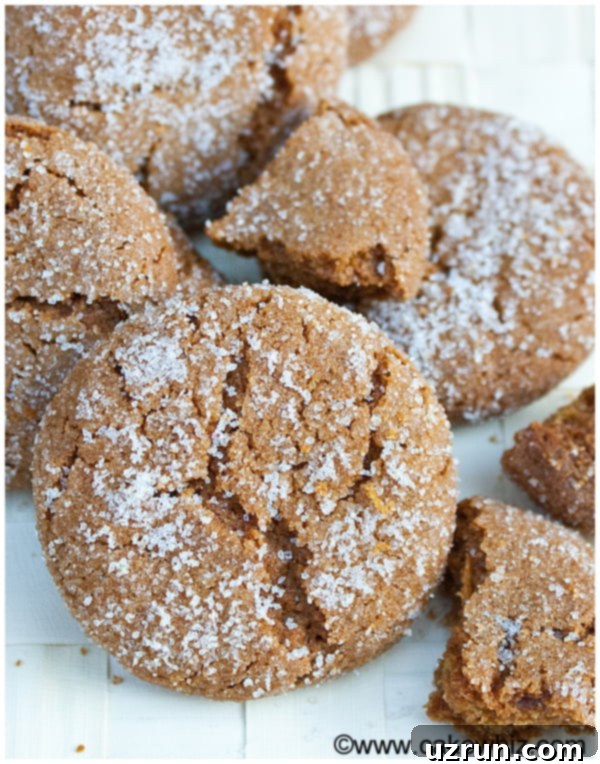Classic Soft & Chewy Molasses Crinkle Cookies: An Easy Homemade Recipe
Step into a world of cozy nostalgia with this incredibly simple and utterly delicious recipe for **Old-Fashioned Molasses Cookies**. These homemade crinkle cookies are a true classic, especially beloved during the holiday season. Featuring a perfect balance of warm spices and a uniquely soft and chewy texture, they’re the kind of treat that brings comfort with every bite. If you’re searching for an easy-to-follow recipe that yields consistently delightful results, look no further. This recipe has been cherished in our family for generations, standing proudly alongside our popular Ginger Cookies and Oatmeal Raisin Cookies – both of which also feature the rich, distinctive flavor of molasses.
Molasses cookies are more than just a dessert; they are a tradition. The enticing aroma of cinnamon, nutmeg, clove, and allspice filling your kitchen is the quintessential scent of holidays and gatherings. Their characteristic crinkled tops, dusted with sparkling sugar, make them as visually appealing as they are delicious. Whether you’re baking for Christmas, a special occasion, or simply to satisfy a sweet craving, these cookies are guaranteed to be a hit. Get ready to create a batch of these timeless treats that are sure to become a cherished favorite in your home too!
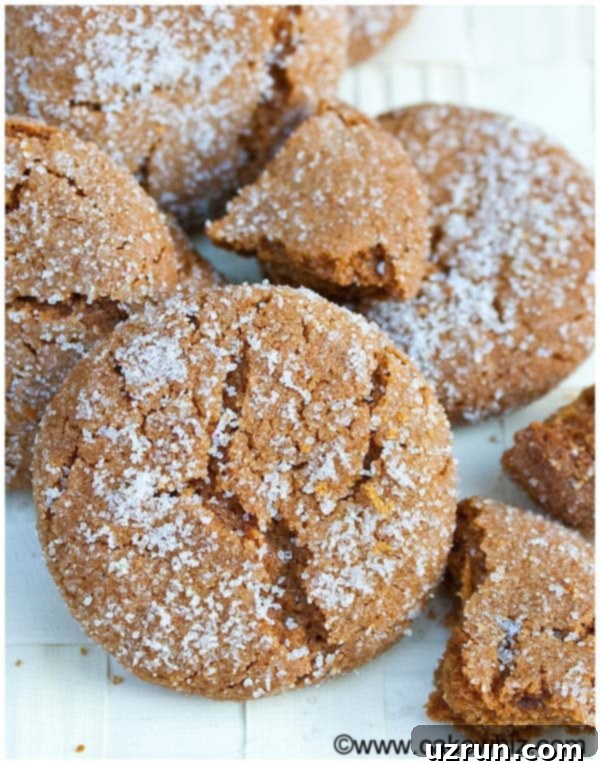
Why You’ll Love This Easy Molasses Cookie Recipe
This molasses cookie recipe isn’t just another cookie recipe; it’s a gateway to heartwarming homemade goodness. Here’s why it will quickly become your go-to:
- Effortlessly Easy: With straightforward instructions and simple ingredients, even novice bakers can achieve perfect results.
- Unbeatable Texture: We’ll reveal the secrets to achieving that ideal soft interior and wonderfully chewy bite, complete with those irresistible crinkled edges.
- Perfectly Spiced: A harmonious blend of classic warm spices creates a fragrant, comforting flavor profile that’s simply irresistible.
- Holiday Staple: These cookies are synonymous with Christmas and other festive occasions, making them a must-have for your holiday baking list.
- Family Favorite: A time-tested recipe passed down through generations, ensuring a taste of tradition in every cookie.
How to Make Easy Molasses Cookies from Scratch: A Step-by-Step Guide
Creating these delightful molasses crinkle cookies is a rewarding experience. Follow these steps for perfect results every time:
- Cream Wet Ingredients: Begin by creaming together softened butter, shortening, and brown sugar until the mixture is light and fluffy. This step is crucial for incorporating air and creating a tender cookie. Then, beat in the egg, molasses, and vanilla extract until everything is smooth and well combined.
- Whisk Dry Ingredients: In a separate bowl, thoroughly whisk together the all-purpose flour, salt, baking soda, cinnamon, nutmeg, clove powder, and allspice. Whisking ensures that the leavening agent and spices are evenly distributed throughout the dough.
- Combine Mixtures: Gently add the dry ingredient mixture to the wet ingredients. Mix until just combined. Be careful not to overmix, as this can develop the gluten in the flour too much, leading to tough cookies. If the dough is a bit stiff, don’t hesitate to use your hands to bring it together.
- Chill the Dough: This is a non-negotiable step! Chilling the dough for at least an hour in the refrigerator makes it much easier to handle and prevents the cookies from spreading too much during baking, ensuring those beautiful crinkles form.
- Form and Roll: Scoop out small portions of the chilled dough and roll them into uniform balls. Then, roll each dough ball generously in granulated sugar or sanding sugar for that iconic sparkle and extra crunch.
- Bake to Perfection: Place the sugared dough balls on a baking tray lined with parchment paper, leaving enough space between them for spreading. Bake in a preheated oven at 375°F (190°C) for approximately 10 minutes, or until the edges are just firm but the centers still look slightly soft.
- Cool and Enjoy: Allow the cookies to cool completely on the baking tray before carefully transferring them to a wire rack. This helps them set and prevents breakage. Then, it’s time to enjoy your freshly baked, soft, and chewy molasses crinkle cookies!
Molasses Cookies vs. Gingerbread Cookies: Understanding the Difference
While both molasses cookies and gingerbread cookies share a delightful spiced flavor and often make an appearance during the holidays, they possess distinct characteristics:
- Spice Profile: The primary difference lies in their dominant spices. Gingerbread cookies, as the name suggests, heavily feature ground ginger, often accompanied by cinnamon, cloves, and nutmeg. Molasses cookies, while also spiced, tend to have a broader blend of warm spices like cinnamon, nutmeg, clove, and allspice, with ginger being optional or in smaller quantities, if present at all. Our specific molasses cookie recipe, for instance, focuses on a rich blend of cinnamon, nutmeg, clove, and allspice, intentionally excluding ginger for a unique taste.
- Texture: This is another significant differentiator. Traditional gingerbread cookies are often made to be thin and crispy, especially when cut into shapes for decorating. Molasses cookies, on the other hand, are celebrated for their wonderfully soft and chewy texture. The inclusion of shortening and the specific ratio of ingredients in this recipe are key to achieving this melt-in-your-mouth softness.
- Appearance: Gingerbread cookies are typically rolled out and cut into various shapes (like gingerbread men, stars, or trees) before baking. Molasses cookies, particularly crinkle versions, are usually rolled into balls and then coated in sugar, which creates their signature crackled surface as they bake.
So, while they both belong to the spiced cookie family, molasses cookies offer a distinct soft, chewy, and broadly spiced experience, perfect for those who adore a comforting, tender bite.
Secrets to Soft and Chewy Molasses Crinkle Cookies
Achieving that coveted soft and chewy texture in your molasses cookies is easier than you think, but it relies on a few critical factors:
- The Butter and Shortening Blend: Our recipe specifically calls for a combination of both shortening and butter. This is not arbitrary! Shortening contributes to a wonderfully soft and tender crumb, as it has a higher melting point and doesn’t contain water like butter. Butter, conversely, provides unparalleled flavor. Using both ensures you get the best of both worlds: incredible taste and a perfectly soft texture.
- The Magic of Molasses: Molasses itself is a natural humectant, meaning it attracts and retains moisture. This quality is fundamental to the chewy characteristic of these cookies, keeping them moist and pliable long after they’ve cooled. Always opt for unsulphured light molasses, as dark or blackstrap molasses has a much stronger, more bitter flavor that can drastically alter your cookie’s taste.
- Precise Baking Time: This is arguably the most crucial tip. Over-baking is the number one culprit for hard, dry cookies. For these molasses cookies, you want to bake them *just* until the edges are set and firm, but the centers still look slightly soft and puffed. This typically takes around 10 minutes in a preheated 375°F (190°C) oven, but ovens vary, so keep a close eye on them. They will continue to set as they cool on the baking sheet.
- Room Temperature Ingredients: Ensure your butter, shortening, and egg are at proper room temperature. This allows them to cream together smoothly and evenly, creating an emulsified mixture that holds air better, contributing to a lighter, softer cookie.
- Accurate Measurement: Baking is a science. Use proper measuring techniques for your flour (spoon and level) and other ingredients to maintain the correct dough consistency. Too much flour can lead to dry, hard cookies.
What is the Best Molasses to Use for Baking?
For these molasses cookies, and most baking recipes, you should use **regular unsulphured light molasses**. It has a mild, sweet, and slightly smoky flavor that complements the spices without overpowering them. It’s often labeled as “original” or “mild” molasses.
Avoid:
- Dark Molasses: This has a much stronger, more robust, and sometimes slightly bitter flavor. While it works in some savory applications, it can drastically change the flavor profile of your cookies, making them less palatable.
- Blackstrap Molasses: This is the darkest and most concentrated form of molasses, with a very strong, bitter taste and a lower sugar content. It’s primarily used for its nutritional benefits or in very specific recipes, not generally for sweet baked goods like these cookies.
- Sulphured Molasses: This type has sulfur dioxide added as a preservative, which can give it a slightly chemical or off-flavor. Unsulphured molasses is preferred for its cleaner taste.
Common Troubleshooting: Why Are My Cookies Flat?
Flat cookies can be disappointing, but it’s a common issue with a few clear culprits:
- Incorrect Flour Measurement: This is one of the most frequent reasons. If there isn’t enough flour, the dough won’t have the structure to hold its shape, causing the cookies to spread excessively. Always measure flour accurately by spooning it into your measuring cup and then leveling it off with a straight edge.
- Melted or Too Soft Butter/Shortening: If your butter and shortening are melted or excessively soft (beyond room temperature), the fat content will cause the cookies to spread rapidly in the oven. Ensure they are softened but still solid, not greasy or liquid.
- Insufficient Chilling: Chilling the dough is essential. Cold dough takes longer to melt in the oven, allowing the cookie structure to set before spreading too much. If you skip or shorten the chilling time, your cookies are more likely to flatten.
- Oven Temperature Issues: An oven that isn’t hot enough can cause cookies to spread before they set. Use an oven thermometer to ensure your oven is accurately preheated to the correct temperature.
- Greased Baking Sheets: Unless specified, avoid greasing your baking sheets. The added fat can make cookies spread more. Parchment paper or silicone baking mats are the best choice for even baking and easy removal.
Why Are My Cookies Hard? How to Soften Homemade Cookies?
Hard cookies can be a result of a couple of common errors, but there’s also a fantastic trick to bring them back to life!
Common Reasons for Hard Cookies:
- Over-baking: As mentioned, baking molasses cookies for too long is the primary reason they turn hard and crispy instead of soft and chewy. Keep a close eye on them and remove them from the oven when the edges are just set.
- Incorrect Ingredient Ratios: Too much flour or not enough fat/molasses can lead to a dry, dense dough that bakes into hard cookies. Always measure carefully!
How to Soften Hard Cookies: The Bread Trick!
These cookies, like many homemade varieties, do have a tendency to firm up after about 24 hours. But don’t despair! The simplest and most effective way to soften them is with a slice of bread:
- Place in an Airtight Container: Gather your hard cookies and place them in an airtight cookie jar or container.
- Add a Slice of Bread: Place one slice of fresh bread (any type, white bread works great) directly into the container with the cookies.
- Seal and Wait: Tighten the lid securely and let it sit overnight, or for several hours.
- Enjoy Soft Cookies: The next morning, you’ll find that the bread has become hard and stale, while your cookies have absorbed its moisture and become wonderfully soft again! Discard the hard bread and enjoy your rejuvenated cookies.
This trick works because the moisture from the bread migrates to the drier cookies, rehydrating them. While microwaving cookies for a few seconds can also soften them in a pinch, the bread trick provides a more lasting and even softness without altering the texture too much.
Delicious Variations & Customizations for Molasses Spice Cookies
While these classic molasses cookies are perfect as is, they also serve as a wonderful base for creative additions and flavor variations:
- Elevate with Icing: Once completely cooled, drizzle or spread a thin layer of icing for extra sweetness and presentation. Consider Royal Icing, a simple Powdered Sugar Glaze {Vanilla Cake Glaze}, a rich Brown Sugar Frosting {So fluffy!}, or a classic American Buttercream Frosting.
- Adjust Spices to Taste: Feel free to customize the spice levels. Add more cinnamon for a bolder flavor, or increase the clove and allspice for a richer, deeper profile. You can also introduce other complementary spices.
- Introduce Other Extracts: A dash of maple, caramel, almond, bourbon, or rum extract can add an intriguing layer of flavor to your cookies. Start with a small amount and adjust to your preference.
- Brighten with Zests: Incorporate fresh orange or lemon zest into the dough. The citrus notes will add a lovely brightness that perfectly complements the warm spices.
- Add More Spices: For an even more complex flavor, consider adding a touch of cardamom or ground ginger (if you prefer a gingerbread-like kick) to the dry ingredients.
- Textural Additions:
- Shredded Coconut: Mix in a handful of finely shredded coconut for added chewiness and a hint of tropical sweetness.
- Oats: For extra fiber and a more robust, chewy texture, fold in 1-2 tablespoons of quick-cooking oats into the cookie dough mixture.
- Nuts: Enhance the crunch and flavor by adding chopped walnuts, pecans, cashews, almonds, or peanuts.
- Crystallized Ginger: For a delightful spicy-sweet chew, mix in ¼ cup of finely chopped crystallized ginger candy. Alternatively, for a fresher, zingier note, use 1.5 tablespoons of freshly grated ginger.
Expert Tips and Techniques for Perfect Molasses Crinkle Cookies
Beyond the recipe steps, these additional tips will help you achieve baking perfection:
- Always Chill the Dough: We’ve stressed this before, but it’s worth repeating. Chilled dough is not only easier to scoop and roll, but it also helps prevent excessive spreading, ensuring your cookies retain their shape and develop those signature crinkles. Don’t skip this step!
- Room Temperature Ingredients are Key: For a smooth, uniform dough, ensure all your wet ingredients like butter, shortening, and egg are at room temperature. This allows them to emulsify properly, creating a consistent batter that bakes evenly.
- Choose Your Sugar for Rolling: While granulated sugar works perfectly well for rolling the cookie balls, using sanding sugar will give them an extra sparkle and a slightly coarser, more noticeable sugary crunch. Both are excellent choices!
- Baking Soda, NOT Baking Powder: This recipe specifically calls for baking soda. Do not substitute it with baking powder. Baking soda reacts with the acidic molasses to create the perfect lift and spread, contributing to the desired soft and chewy texture. Baking powder has a different chemical composition and will not yield the same results.
- What to Expect Flavor-Wise: These cookies offer a delightful sensory experience. They are sweet, deeply spiced with warm notes of cinnamon, nutmeg, clove, and allspice, and boast a perfectly soft and wonderfully chewy texture that melts in your mouth.
- Don’t Be Afraid to Use Your Hands: Sometimes, especially after adding the dry ingredients, the dough might seem a bit crumbly. If needed, use clean hands to gently knead and bring everything together into a cohesive cookie dough consistency. This ensures all ingredients are well incorporated without overmixing.
- Line Your Baking Trays: Always line your baking trays with parchment paper or a silicone baking mat. This prevents the cookies from sticking, promotes even baking, and makes for effortless removal without breaking those delicate crinkles.
- Consider Your Oven: Ovens can vary significantly in temperature. If you find your cookies are baking too fast or too slow, consider using an oven thermometer to verify accuracy. Adjust baking time as needed based on your oven’s performance.
Storage of Homemade Molasses Cookies
Proper storage ensures your molasses cookies remain delicious for as long as possible:
- Room Temperature: Store baked and cooled cookies in an airtight container or cookie jar at room temperature for up to 3 days. To maintain maximum softness, remember the bread slice trick mentioned above!
- Refrigerate: For slightly longer storage, you can keep them in a sealed container in the refrigerator for up to 5 days. Be aware that they might firm up a bit more when cold.
- Freeze: These cookies freeze beautifully! Place cooled cookies in a single layer on a baking sheet and freeze until solid. Then, transfer them to a freezer-safe bag or airtight container, separated by parchment paper, for up to 1 month. Thaw them to room temperature before enjoying again. Note that while they will still be delicious, their texture might be slightly less soft and chewy after freezing and thawing.
- Freezing Dough: You can also freeze the raw cookie dough. Roll the dough into balls, then freeze them on a baking sheet. Once solid, transfer to a freezer bag. When ready to bake, place frozen dough balls on a parchment-lined sheet, allow to thaw slightly on the counter (about 15-20 minutes), roll in sugar, and bake as directed, possibly adding a minute or two to the baking time.
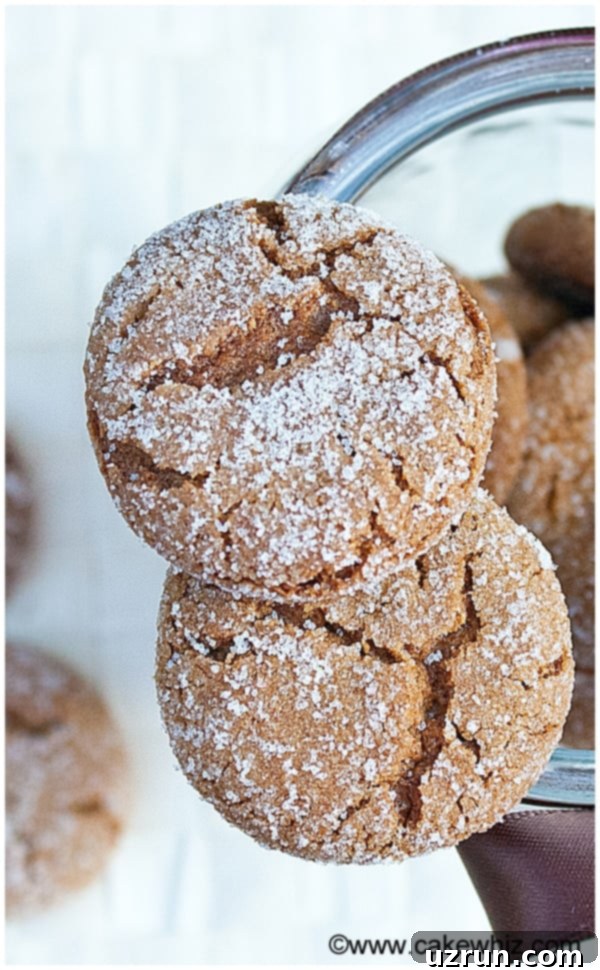
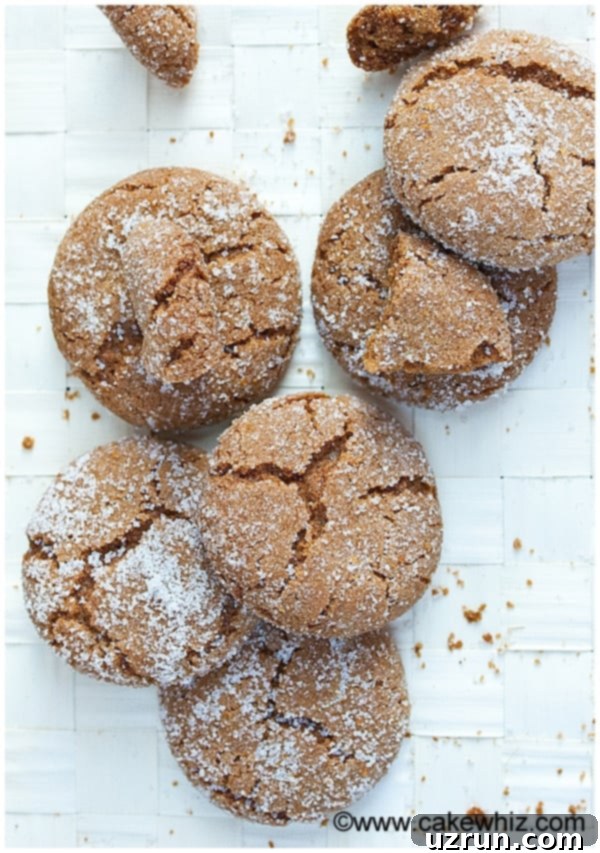
More Classic Cookie Recipes to Explore
If you love these molasses crinkle cookies, you’ll surely enjoy these other classic cookie recipes from our collection:
- Caramel Snickerdoodle Cookies
- Classic Snickerdoodles Cookies
- Churro Cookies
- Classic Spritz Cookies
- Peanut Butter and Jelly Thumbprint Cookies
- Small Batch of Sugar Cookies
- Crackly Sugar Cookies
- Red Velvet Crinkle Cookies
- Classic No Bake Cookies Recipe
- Chocolate Thumbprint Cookies
- Easy Cake Mix Gingerbread Cookies
Recipe Card: Easy Molasses Cookies
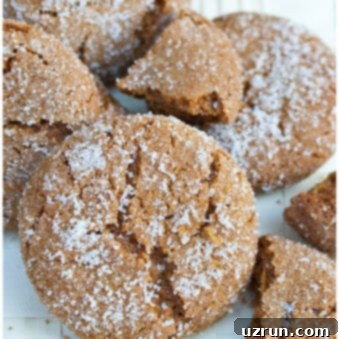
Molasses Cookies
Abeer Rizvi
Pin Recipe
Want to Save This Recipe?
Enter your email & I’ll send it to your inbox. Plus, get great new recipes from me every week!
By submitting this form, you consent to receive emails from CakeWhiz
Ingredients
- ½ cup Butter Unsalted
- ¼ cup Shortening
- 1 cup Brown sugar
- 1 Egg Large
- ¼ cup Molasses
- ½ teaspoon Vanilla extract
- 2 ¼ cups All-purpose flour
- ¼ teaspoon Salt
- 2 teaspoon Baking soda
- 1½ teaspoon Cinnamon
- 1 teaspoon Nutmeg
- ½ teaspoon Clove powder
- ½ teaspoon Allspice powder
- 1 cup Granulated sugar For rolling cookie balls
Instructions
-
Cream together butter, shortening and brown sugar until fluffy.
-
Add egg, molasses, vanilla extract and mix until smooth.
-
In a separate bowl, whisk together the flour, salt, baking soda, cinnamon, nutmeg, clove powder, allspice.
-
Dump this dry mixture into the wet mixture and mix until just combined. Use your hands, if necessary to mix everything into a cookie dough consistency.
-
Chill for at least an hour in the fridge so that dough is easier to handle.
-
Scoop out small portions of the dough and make small balls.
-
Roll them in a bowl of granulated sugar and place them on a cookie tray, lined with parchment paper.
-
Bake at 375 degrees F for 10 minutes or until edges are firm.
-
Allow the cookies down completely in the tray before removing them and enjoy.
-
Allow the cookies down completely in the tray before removing them and enjoy.
Notes
- Read all my tips above.
- Leftovers can be stored in a cookie jar at room temperature for up to 3 days.
Nutrition
An automated tool is used to calculate the nutritional information. As such, I cannot guarantee the accuracy of the nutritional information provided for any recipe on this site.
